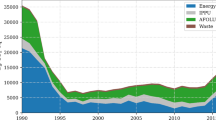Abstract
In order to respond to climate change, it is essential to describe possible future greenhouse gas (GHG) emission trajectories in both nonintervention and intervention terms. This paper analyzes long-term GHG mitigation emission scenarios according to alternative development paths in the world and major regions, based on the nonintervention emission scenarios quantified by the Asian-Pacific Integrated Model (AIM). AIM is revised and applied to the quantification of narrative storylines for scenarios of socioeconomic development, and GHG emissions from energy use, land-use change, and industrial production processes are simulated. A wide range of mitigation policies are adopted in this simulation as responses to the climate change. Several target stabilized levels—650, 550 and 450ppmv—are analyzed. The results show that to achieve stabilization at a different GHG concentration level, a policy package is essential to reach the target concentration level, rather than a single policy. Energy efficiency improvement will be a key contributor to the reduction of GHG emissions as a result of the policy package. The mitigation cost could be at a medium level, without a large loss of economic growth. The developing world could significantly reduce GHG emissions compared with nonmitigation scenarios with sufficient knowledge transfer from developed countries.
Similar content being viewed by others
References
Alcamo J, Bouwman A, Edmonds J, Gruebler A, Morita T, Sugandhy A (1995) An evaluation of the IPCC IS92 emission scenarios. In: Climate change 1994: radiative forcing of climate change and an evaluation of the IPCC IS92 emission scenarios. Cambridge University Press, pp 247–304
AIM Project Team (1996) A guide to the AIM/end-use model, AIM interim paper, IP-95-05, Tsukuba, Japan
Bruce J, Lee H, Haites E (eds) (1996) Climate change 1995—economic and social dimensions of climate change. WGIII of IPCC, Cambridge University Press
Edmonds J, Reilly J (1983) A long-term global energy-economic model of carbon dioxide release from fossil fuel use. Energy Economics 5:75–88
Edmonds J, Wise M, Barns D (1995) Carbon coalitions: the cost and effectiveness of energy agreement to alter trajectories of atmospheric carbon dioxide emissions. Energy Policy 23:309–335
Edmonds J, Wise M, Sands R, Brown R, Kheshgi H (1996) Agriculture, land use, and commercial biomass energy: a preliminary integrated analysis of the potential role of biomass energy for reducing future greenhouse related emissions. Pacific Northwest National Laboratory, Washington, D.C.
Gan L (1998) Energy development and environmental constraints in China. Energy Policy 26:119–128
Hertel T (1997) Global trade analysis. Cambridge University Press
Hibino G, Kainuma M, Matsuoka Y, Morita T (1996) Two-level mathematical programming for analyzing subsidy options to reduce greenhouse gas emissions. Working Paper, International Institute for Applied System Analysis (IIASA), Laxenburg
Hu X, Jiang K, Liu J (1996) Application of AIM/emission model in P.R. China and preliminary analysis on simulated results. AIM Interim Paper, IP-96-02, Tsukuba, Japan
Jiang K, Hu X, Matsuoka Y, Morita T (1998) Energy technology changes and CO2 emission scenarios in China. Environment Economics and Policy Studies 1:141–160
Jiang K, Masui T, Morita T, Matsuoka Y (2000) Long-term GHG emission scenarios of Asia-Pacific and the world. Techological Forecasting & Social Change 61(2–3). (in press)
Lashof DA, Tirpak D (1990) Policy options for stabilizing global climate, 21P-2003 U.S. Environmental Protection Agency, Washington, D.C.
Matsuoka Y, Morita T (1996) Recent global GHG emission scenarios and their climatic implications. In: Amano A (ed) Global warming, carbon limitation and economic development, CGER, Tsukuba, Japan, pp 117–136
Morita T, Matsuoka Y, Penna I, Kainuma M (1994) Global carbon dioxide emission scenarios and their basic assumptions, 1994 Survey. CGER, Tsukuba, Japan
Parikh J (1992) IPCC strategies unfair to the south. Nature 360:507–508
Qi L, Hao L, Lu M (1995) SO2 emission scenarios of Eastern China. Water, Air and Soil Pollution 85:1873–1878
World Energy Council (WEC) (1993) Energy for tomorrow’s world. St. Martin’s Press, New York
Zhou F, Jiang K, Hu X (1997) Make progress for modeling in China. In: Climate change and integrated assessment models—bridging the gaps. Proceedings of the IPCC Asia-Pacific Workshop on Integrated Assessment Models, March 1997, CGER, Tsukuba, Japan
Author information
Authors and Affiliations
About this article
Cite this article
Jiang, K., Morita, T., Masui, T. et al. Global long-term greenhouse gas mitigation emission scenarios based on AIM. Environ Econ Policy Stud 3, 239–254 (2000). https://doi.org/10.1007/BF03354039
Received:
Accepted:
Published:
Issue Date:
DOI: https://doi.org/10.1007/BF03354039




